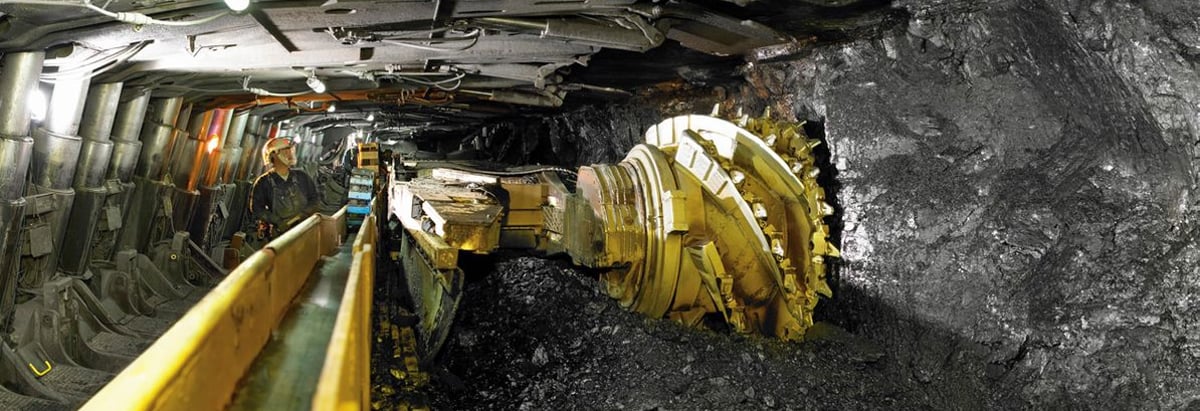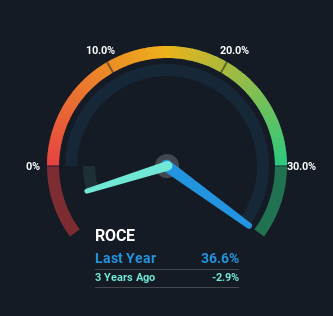- United States
- /
- Oil and Gas
- /
- NYSE:BTU
We Think Peabody Energy (NYSE:BTU) Might Have The DNA Of A Multi-Bagger

Finding a business that has the potential to grow substantially is not easy, but it is possible if we look at a few key financial metrics. Firstly, we'd want to identify a growing return on capital employed (ROCE) and then alongside that, an ever-increasing base of capital employed. Basically this means that a company has profitable initiatives that it can continue to reinvest in, which is a trait of a compounding machine. And in light of that, the trends we're seeing at Peabody Energy's (NYSE:BTU) look very promising so lets take a look.
Understanding Return On Capital Employed (ROCE)
Just to clarify if you're unsure, ROCE is a metric for evaluating how much pre-tax income (in percentage terms) a company earns on the capital invested in its business. Analysts use this formula to calculate it for Peabody Energy:
Return on Capital Employed = Earnings Before Interest and Tax (EBIT) ÷ (Total Assets - Current Liabilities)
0.37 = US$1.8b ÷ (US$5.8b - US$866m) (Based on the trailing twelve months to March 2023).
Thus, Peabody Energy has an ROCE of 37%. In absolute terms that's a great return and it's even better than the Oil and Gas industry average of 23%.
Check out our latest analysis for Peabody Energy

Above you can see how the current ROCE for Peabody Energy compares to its prior returns on capital, but there's only so much you can tell from the past. If you'd like, you can check out the forecasts from the analysts covering Peabody Energy here for free.
What Can We Tell From Peabody Energy's ROCE Trend?
You'd find it hard not to be impressed with the ROCE trend at Peabody Energy. The data shows that returns on capital have increased by 259% over the trailing five years. That's not bad because this tells for every dollar invested (capital employed), the company is increasing the amount earned from that dollar. Interestingly, the business may be becoming more efficient because it's applying 28% less capital than it was five years ago. If this trend continues, the business might be getting more efficient but it's shrinking in terms of total assets.
In Conclusion...
In a nutshell, we're pleased to see that Peabody Energy has been able to generate higher returns from less capital. Astute investors may have an opportunity here because the stock has declined 50% in the last five years. So researching this company further and determining whether or not these trends will continue seems justified.
Peabody Energy does have some risks though, and we've spotted 1 warning sign for Peabody Energy that you might be interested in.
High returns are a key ingredient to strong performance, so check out our free list ofstocks earning high returns on equity with solid balance sheets.
New: Manage All Your Stock Portfolios in One Place
We've created the ultimate portfolio companion for stock investors, and it's free.
• Connect an unlimited number of Portfolios and see your total in one currency
• Be alerted to new Warning Signs or Risks via email or mobile
• Track the Fair Value of your stocks
Have feedback on this article? Concerned about the content? Get in touch with us directly. Alternatively, email editorial-team (at) simplywallst.com.
This article by Simply Wall St is general in nature. We provide commentary based on historical data and analyst forecasts only using an unbiased methodology and our articles are not intended to be financial advice. It does not constitute a recommendation to buy or sell any stock, and does not take account of your objectives, or your financial situation. We aim to bring you long-term focused analysis driven by fundamental data. Note that our analysis may not factor in the latest price-sensitive company announcements or qualitative material. Simply Wall St has no position in any stocks mentioned.
About NYSE:BTU
Very undervalued with flawless balance sheet.
Market Insights
Community Narratives



